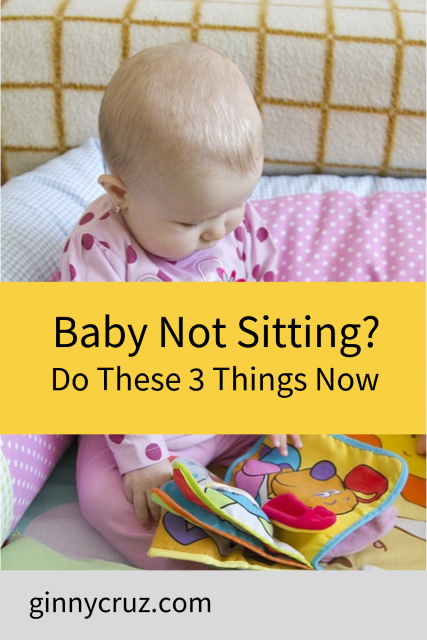Baby Not Sitting? Do These 3 Things Now
Most babies learn to sit without support by seven months of age. This is the average—some learn it sooner and others later. If your baby is at least four months old, this blog post is for you.
In previous posts, I’ve discussed the problem of Container Baby Syndrome (a container is any device designed to hold a baby, such as a car seat). Miss it? Catch it here. While most babies seem to avoid developmental delays, even when spending a lot of time contained, many do end up with delays in gross motor skills such as not sitting by seven months.
Without going into more detail than you have time or energy for, let’s get down to the brass tacks of the matter—your baby needs more practice learning to sit. Just like any skill, regular practice is required. Ready to dive in?
Here are my top 3 things for you to do beginning NOW:
- Take an honest assessment of how much time your sweet baby is sitting in a container of some type. Add up the total minutes in a day. It may be more time than you realized. Don’t despair and say to yourself, “I’m a bad mother.” You are a real mother that needs to make some adjustments to her schedule. Acknowledging this and taking action are the first steps.
- Make adjustments to your baby’s schedule to allow time to practice sitting. This works best when you work in a few minutes multiple times a day rather than a big chunk of time once a day. For example, after the morning feeding and dressing is done, get down on the floor with your baby for fifteen minutes. Play together and talk. Do not just veg out in front of screens.
- Give your baby the freedom to practice, by surrounding him with a Boppy pillow, pillows, or cushions so when he topples over, he doesn’t get hurt. Baby containers restrain movement and do not allow the freedom to fall. And, your baby cannot learn to sit without learning how to prevent a fall. As he gets better, schedule more time but you must have eyes on him at all times. This is not the time to get distracted or take a shower!
Moms always ask, “How much time does my baby need to practice?” Sorry to tell you but there’s no magic answer but do this. Compare the total minutes your baby is contained in a seat, swing, or other safe spots with the number of minutes your baby is practicing sitting on the floor.
Here’s an example: Say your baby is in the car seat/carrier a total of sixty minutes most days. Don’t scoff. Trips to Target, doctor’s offices, and a quick coffee at Starbucks add up. When you get home after feeding and changing the baby, you may have twenty minutes of time to practice sitting. In this example, your baby is contained three times more minutes than he is uncontained. Do something to change that. Maybe add another twenty minutes of sitting in the evening or think twice about putting him in the swing (another container) in front of the TV. Little changes can make big differences!
Important Note: Some babies will still have trouble learning to sit even doing all I’m suggesting and maybe more. As I stated at the beginning, most babies learn to sit by seven months of age. For premature babies, by seven months adjusted age, not chronological.
Many doctors will tell you to wait and see for a few more months before taking action. Most pediatric physical therapists will not recommend therapy for a delay in sitting unless the delay is at least three months or other factors are contributing, such as low muscle tone or a diagnosis known to cause delays (i.e., Downs Syndrome).
If you are concerned, consider contacting your local early intervention office. A doctor’s referral is not required and see if your child needs services. Find an office here. Early intervention services are FREE.
If you’re worried and your child’s doctor isn’t, what’s the harm of contacting them? I can’t think of a good reason to wait. Delays are remediated faster when discovered and addressed early.
I’d love to send you my FREE Tips for Concerned Moms. Got a burning question? Shoot me an email or comment below. I’d love to help.
(Photo from Pixabay)

 God knows what you need, even when you don't.
God knows what you need, even when you don't.

